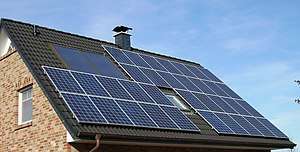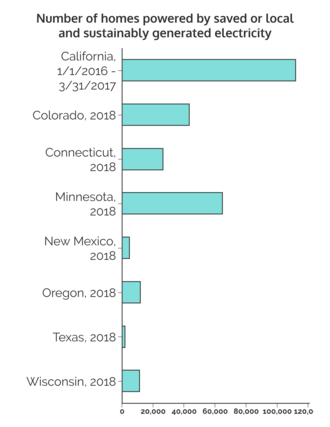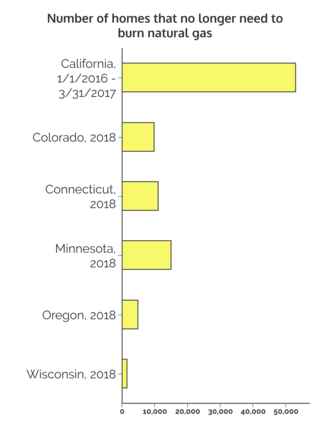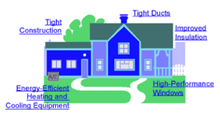Home energy upgrades from public utilities
Home energy upgrades from public utilities are added home energy efficiency and renewable energy features planned or installed by public utilities. Help from a public utility can make it easier for a homeowner to select, install or operate climate-friendly components. The utility might assist with coordinated use of utility-supplied energy, building features, financing, operating options and neighborhood supplied energy.[1]

Current programs
Various public utilities, related organizations and governments have started or considered programs offering home energy upgrades from public utilities.
North America
Programs are underway in a number of states within the United States.
Alaska

Alaska’s capital city Juneau may ease itself away from using heating oil, replacing it with heat pumps powered by hydroelectricity. The local utility, Alaska Electric Light & Power, is considering the first steps toward encouraging customers to install heat pumps.[2] Heat pump installations may be air sourced or geothermal. (Videos can be found describing both air source[3] and geothermal[4] installations.)
California
The California Public Utilities Commission is helping builders to construct new homes that will contribute as much energy to the public utilities as they extract from them.[5] California's goal is 100% of new homes at Zero Net Energy beginning in 2020. Coordinated help for owners of existing homes is provided by the Energy Upgrade California[6] website. Data reported for the period from January 2016 through March 2017 indicates that residential efficiency efforts of the major California public utilities had saved enough electricity to provide electricity for about 112,000 typical US homes, and had saved enough natural gas to supply natural gas to about 53,000 typical US homes.[7][8]
Colorado
Started in northern Colorado in 2014, the Efficiency Works program is offered by Estes Park Light & Power, Fort Collins Utilities, Longmont Power & Communications, Loveland Water and Power, and Platte River Power Authority. On its website, Efficiency Works states that it "has achieved energy savings equivalent to the average energy use of 10,000 homes in our communities, and we plan to continue increasing our energy savings goals each year" (as of December 31, 2017).[9]
Efficiency Works can assess the efficiency of a customer's home, assign an efficiency adviser who walks the homeowner through the upgrade process from start to finish, and coordinate an energy audit.[10] The utility’s customers, residential and commercial, are guided in a wide range of topics including installation strategies, on-site solar generation, and battery storage.[11] In 2017, Fort Collins Utilities identified important features and issues for Efficiency Works to succeed, including finding the best ways to invite customers to participate, assuring the quality of contractor work, and providing an assigned impartial adviser to coordinate all work for a given home.[12]
Xcel Energy, a major central states public utility, serves customers in various locations throughout Colorado.[13] Xcel's efficiency programs have helped Colorado homes upgrade appliances, lighting, and energy use monitoring - as well as Heating, Ventilation and Air Conditioning systems.[14] Xcel's reported energy savings in 2018, due to its assistance to customers (both residential and business), indicate electricity savings sufficient to supply about 43,600 typical US homes with electricity, and natural gas savings sufficient to supply about 9,900 typical US homes with natural gas.[14][8]

Connecticut
Energize Connecticut has helped 4 public utilities in the state of Connecticut to actively assist homeowners who want to save money and use clean energy.[15] For a small fee, experts assess a home’s energy performance and install weatherization, seal air leaks, install energy-efficient lighting, install faucet aerators, and replace old shower heads with low-flow models.[16] Assisted homes each get an average of about $1,000 in services, resulting in annual energy savings of $200-$250.
During an energy assessment technicians provide recommendations for efficient Wi-Fi thermostats, insulation, space heating, cooling, water heating, windows and appliances. Recommendations include information on rebates, financing and investment analysis. An Energize video shows how the energy assessment process works.[17]
Energize Connecticut is an initiative of the Energy Efficiency Fund,[18] the Connecticut Green Bank,[19] the State of Connecticut, local electric utilities and local gas utilities. The guiding board for Energize Connecticut's key funding reported that, in 2018, its residential programs saved 277,000 megawatt hours of electricity (enough electricity to supply about 26,600 typical homes in the United States) and 6,800,000 CCF of natural gas (enough natural gas to supply about 11,100 typical homes in the United States).[20][8]
Florida
Florida Public Utilities (FPU) can send an Energy Expert to a customer's home to evaluate energy use.[21] During a free visit, the Energy Expert will review a home's energy use history and evaluate the energy efficiency of walls, windows, insulation, appliances, lighting and other features. The homeowner also receives help applying for rebates on high-efficiency upgrades that will add comfort and value.
As a part of Chesapeake Utilities, FPU distributes natural gas, propane and electricity in various locations in Florida.
Michigan
The Xcel Energy utility pursues its goal to provide customers with energy saving assistance. Xcel's service area in the state of Michigan includes several communities south of Lake Superior.[13] In 2018, Xcel's assistance programs in Michigan saved enough electricity to supply about 120 typical US homes and enough natural gas to supply about 100 typical US homes.[14][8] Xcel Energy is part of Michigan's Efficiency United collective[22] that informs residential and commercial customers about energy efficiency and offers cost-effective solutions and rebates for reducing energy use.

Minnesota
In 2018 Xcel Energy's home and business efficiency programs in Minnesota saved enough electricity to supply electricity to about 65,000 typical US homes.[14][8] These programs also saved enough natural gas to supply natural gas for about 15,000 typical US homes.[14][8] Xcel has been giving its customers “more control and new options for using and managing energy”. The utility began tracking results for its efficiency assistance programs in 1992.
Xcel's Minnesota Home Energy Squad, One-Stop Efficiency Shop and Partners in Energy programs received the 2019 Exemplary Program Award from the American Council for an Energy-Efficient Economy (ACEEE).[14] In 2018 Xcel was acknowledged to be the first major, multi-state U.S. utility to commit to 100 percent carbon-free electricity by 2050.[23] Although Minnesota is one of Xcel Energy’s largest service areas, Xcel also provides energy services in Michigan, Wisconsin, North Dakota, South Dakota, Colorado, Texas and New Mexico.
Xcel has worked with Google to develop new ways for customers to manage their energy use. Customers can talk to Google Assistant and ask Xcel for energy-saving tips.[24]
New Mexico
In eastern New Mexico, Xcel Energy helps electricity customers to use energy more efficiently. Xcel reported its assistance to customers saved a total of 51.7 GWh of electricity in 2018[14] (enough electricity to supply about 5,000 typical homes in the United States[8]).
North Dakota
In North Dakota, Xcel Energy is helping residential customers do home energy audits.[14] Xcel serves electric and natural gas customers in the Fargo, Grand Forks and Minot areas of North Dakota.[13] The natural gas savings reported by Xcel for its business and residential assistance programs in 2018 would have been sufficient to supply about 210 typical US homes with natural gas.[14][8]
Oregon
In the state of Oregon, the Energy Trust of Oregon is a nonprofit organization guided by the Oregon Public Utility Commission. Funded from small charges on utility bills, the Energy Trust of Oregon helps public utilities in Oregon offer their customers efficiency advice, contracting assistance, cash incentives and financing.[25] In 2018 Energy Trust of Oregon programs saved enough grid supplied electricity to power about 12,100 typical US homes, and saved enough natural gas to supply about 4,900 typical US homes.[26][8]
The Portland General Electric (PGE) public utility, which distributes about one third of Oregon's electricity,[27] is developing a smart grid test bed to prepare for the utility's routine use of smart grids. A smart grid can, for example, pre-heat or pre-cool a home so that less energy is needed during a peak time.[28] If many homes temporarily shift energy use away from peak times, the utility will not have to build a new fossil fueled power plant just for the handful of hottest or coldest days each year.
PGE's October 2018 press release stated that the test bed project "aims to accelerate PGE’s vision for a clean energy future through partnering with customers to decarbonize the grid".[29] The test bed includes three smart grids to serve more than 20,000 customers. The test bed will make additional renewable energy sources available for a home’s use.
South Dakota
Xcel Energy encourages its South Dakota electricity customers to be energy efficient by upgrading lighting and by shifting their use of electricity away from peak times.[14][13] Xcel's business and residential assistance programs in 2018 saved enough electricity to supply about 580 typical US homes with electricity.[14][8]
Texas
In 2018, Xcel Energy offered energy efficiency guidance to its Texas business and residential customers that helped them to save enough electricity to supply about 2,000 typical US homes.[14][8] Xcel is the electric utility for communities in the northern part of Texas, where Xcel has about 262,000 customers.[13]
Vermont
In Vermont, starting in 2017, the Green Mountain Power (GMP) public utility has helped its residential customers to install Tesla Powerwall 2.0 batteries in their homes.[30][31] Using Tesla’s software platform, GMP can aggregate 2,000 Powerwall home batteries in the utility's pilot program to reduce system-wide peak load by 10 MW, which is the equivalent of removing about 7,500 homes from the grid at peak times.[32][33]
Washington
Clark Public Utilities in southwestern Washington state offers many programs to help make customers’ homes both energy-efficient and comfortable. Energy counselors are available to help homeowners explore options.[34]
Clark offers financing to its residential customers for heat pumps, weatherization, rooftop solar, and solar water heaters. Clark's New Construction programs provide energy efficiency guidance and incentives to new home builders and to manufactured home builders, retailers and buyers.[35]
Wisconsin
In 2018, the electricity savings reported for Xcel Energy's residential and business efficiency assistance programs in Wisconsin was enough to supply electricity for about 11,500 typical US homes.[14][8] Similarly, reported natural gas savings were sufficient to supply about 1,600 homes.[14][8] Xcel cooperates with a statewide program, Focus on Energy, that offers incentives to Wisconsin residents and businesses for installing cost-effective energy efficiency and renewable energy projects. Xcel serves many communities in Wisconsin.[13]
Asia
India's national and state governments have considered new policies to guide public utilities toward providing help to homeowners who want to install rooftop solar projects.[36] Help may include financing, net metering, and installation. Organizations envisioning this approach include the Ministry of New and Renewable Energy, the Climate Policy Initiative, India's state governments, and state-level public electricity distribution companies.
China's energy use per person has been far lower than many developed countries but is expected to rise as household incomes rise and the Chinese economy shifts toward more activity in the service industries.[37] As a critical step that can help guide property owners, China has implemented a Standard for Energy Consumption of Residential Buildings.[38] The Rocky Mountain Institute observed that "no other countries with building stock volume similar to China’s had released a similar national standard".[38]
Australia/Oceania
Australian utilities have considered home upgrade offerings as a way to participate in a growing home battery storage market.[39] Sellers of home storage batteries have been partnering with public utilities. The utilities have sought a closer relationship with homeowners whose home storage batteries can help balance grid load and thus reduce the need for new conventional power plants.[40]
Europe
Électricité de France (EDF) has made a commitment to putting its residential customers' energy-saving plans into practice. EDF provides smart meters and ability to monitor energy consumption from computers or smartphones. On its website, EDF states that residential customers "who want to invest in saving energy need look no further than EDF for precisely the right services and advice, from a home energy performance assessment to advice on heating systems (smart radiators, heat pumps, solar water heating, etc.) and the installation of energy-efficient solutions (LED lighting and heating system regulators and programmers)".[41]
Business model
A business model, Integrated Utility Services,[42] has been described by Rocky Mountain Institute.
Economics
Public utilities may be able to offer home energy upgrades that are as profitable to the utility as the profit from conventional utility-supplied electricity and natural gas. Rocky Mountain Institute published a revenue and cost estimate in December 2014, developed by participants from Rocky Mountain Institute, Fort Collins Utilities, Brendle Group, Colorado Clean Energy Cluster and Telluride Research Group. Their report projected that with substantial sale of home energy upgrades, Fort Collins Utilities total income from its single-family business would increase slightly, with income as a percentage of revenue rising from 8% to 12%.[43]
Upgrades

Utilities can help homeowners to choose upgraded features in new homes, or to do green retrofits of existing homes.[44]
Examples of new home features include energy efficient orientation[45] and thermal mass walls. Use of home Geothermal Heat Pumps (heating and/or cooling systems that transfer heat to or from the ground) can be attractive for a public utility by reducing demand for energy from the grid at peak times, enabling the utility to avoid building new power plants.[46]
Retrofit examples include sealing air leaks,[47] installing building insulation, and replacing or repairing windows.[48] A utility can help homeowners install solar panels, either directly at their homes or indirectly at a community solar farm.[49]
See also
References
- Better Buildings Residential Network CASE STUDY: FORT COLLINS, COLORADO (PDF). U.S. Department of Energy. 2017. pp. 2-8 CBSM IN EFFICIENCY WORKS (In 2016, Fort Collins created the Efficiency Works Neighborhoods pilot program to increase the rates of participation, achieve higher energy savings, and make the upgrade process as simple as possible for homeowners.).
- "Juneau Renewable Heating". Rocky Mountain Institute. Retrieved February 22, 2019.
- "How It Works: Air Source Heat Pump". Mississippi Power Channel On YouTube. May 13, 2014.
- "How a Geothermal Heat Pump Works". This Old House. October 14, 2014. Archived from the original on 2014-10-14.
- "Residential ZNE Action Plan". California's Zero Net Energy Action Plan. Retrieved 2018-10-26.
- "Home Energy Efficiency: How to Assess & Improve | Energy Upgrade California®". www.energyupgradeca.org. California Public Utilities Commission and California Energy Commission. Retrieved 2018-10-26.
- "EEDataPortal". California Energy Efficiency Statistics. Retrieved September 3, 2019.
- The number of typical homes is estimated from reported energy savings after converting units of measure, with typical US home usage rates from "How much electricity does an American home use?", U.S. Energy Information Administration, October 26, 2018, for electricity, and from "Natural Gas Facts", TECO Peoples Gas, 2015, for natural gas.
- "About Us - Efficiency Works". Efficiency Works. Retrieved 2018-10-26.
- "Homes - Efficiency Works". Efficiency Works. Retrieved 2018-10-26.
- "Solar and Energy Storage Reduces Demand - Efficiency Works". Efficiency Works. 2018-08-23.
- DEED Grant #1042 Final Report (PDF). City of Fort Collins. 2017. pp. 19-20 Lessons Learned.
- "Communities Served". Xcel Energy. At the upper left, select the name of the state. Retrieved May 7, 2019.
- "Encouraging Efficient Energy Use". Xcel Energy. At the upper left, select the name of the state and then scroll down to the information for that state. Retrieved September 3, 2019.
- "Empowering Connecticut to Make Smart Energy Choices". Energize Connecticut. 18 December 2012. Retrieved August 4, 2019.
- "Home Energy Solutions-Core Services". Energize Connecticut. Retrieved August 4, 2019.
- "Home Energy Solutions-Core Services". Energize Connecticut. Follow the link to this web page and scroll down and click or touch the video window on the right. Retrieved August 4, 2019.
- O'Connor, Taren (June 28, 2017). "Why raiding Connecticut's Energy Efficiency Fund is a bad idea". The CT Mirror.
- "Start Here". Connecticut Green Bank. Retrieved August 4, 2019.
- "Statewide Energy Efficiency Dashboard". Energize Connecticut. 6 October 2015. Retrieved September 1, 2019.
- "Free Home Energy Check-Ups". Florida Public Utilities. Retrieved July 20, 2019.
- "Ready to Save?". Efficiency United. Retrieved May 12, 2019.
- Lovins, Amory (December 13, 2018). "What utilities can teach us about fighting climate change". GreenBiz.
- "Energy Saving Tips". Xcel Energy. At the upper left, select the name of the state. This web page can also be accessed verbally from a device that has Google Assistant installed: Say something like "Xcel energy saving tips?". Retrieved July 10, 2019.
- "About Us". Energy Trust of Oregon. Retrieved September 22, 2019.
- "2018 Annual Report to the Oregon Public Utility Commission & Energy Trust Board of Directors" (PDF). Energy Trust of Oregon. April 15, 2019. Page 7.
- Decker, Megan. "2017 OREGON UTILITY STATISTICS" (PDF). Oregon Public Utility Commission. Page 12. Retrieved September 22, 2019.
- "Tandem". Portland General Electric. Archived from the original on 2019-02-07. Retrieved February 4, 2019.
- "Portland General Electric announces ambitious Smart Grid Test Bed". Portland General Electric. October 11, 2018.
- "Our Mission". Green Mountain Power. Retrieved September 26, 2019.
- "Innovative Customer Programs" (PDF). Green Mountain Power. 2018. Page 2-8.
- "Innovative Customer Programs" (PDF). Green Mountain Power. 2018. Page 2-9.
- Kelly, Kristin (August 19, 2019). "Green Mountain Power recognized for energy storage". VTDigger.
- "Reducing Waste". Clark Public Utilities. Retrieved March 12, 2019.
- "Rebates & Loan Programs". Clark Public Utilities. Retrieved September 28, 2019.
- "The Drivers and Challenges of Third Party Financing for Rooftop Solar Power in India - CPI". CPI. September 2016.
- "Reinventing fire: China – the role of energy efficiency in China's roadmap to 2050". Eceee Summer Study Proceedings: 115–117. Summer 2017.
- "9 Hot Topics in Carbon Reduction and the Energy Industry in China in 2017, Part 1 - Rocky Mountain Institute". Rocky Mountain Institute. 2018-04-23.
- "Can Battery Storage Recharge Australian Utilities?". gtm. Greentech Media. 2016-07-18.
- "Australian Utility Explores Solar-Plus-Storage and Demand Response for Substation Deferral". gtm. Greentech Media. 2018-04-12.
- "Products and services". EDF France. EDF. Retrieved 2018-10-29.
- Integrated Utility Services (PDF). Rocky Mountain Institute. 2014. Executive Summary. p. 6.
- Integrated Utility Services (PDF). Rocky Mountain Institute. 2014. p. 26.
- Goldemberg, José (2012). Energy: What Everyone Needs to Know. Oxford University Press. pp. 110–112. ISBN 978-0199812905.
- Holmes, Mike (September 17, 2016). "Use orientation of home to directly benefit your wallet and your wellbeing". National Post. Toronto.
- Reference Book on Geothermal Direct Use. U.S. Government Department of Energy. 2017. Kindle Locations 86-100. ISBN 978-1549992834.
- "Locating Air Leaks". Energy Star. U.S. Environmental Protection Agency and U.S. Department of Energy. Retrieved November 18, 2018.
- Garskof, Josh (May 3, 2016). "5 Things to Know Before You Replace Windows". Money. Time Inc.
- Hough, Vince (2016). Residential Solar Energy. CreateSpace. pp. 1–3. ISBN 978-1539536703.
External links
- Behavioural Energy Efficiency Potential for India
- C40 China Buildings Programme
- Customer Energy Efficiency Programs: ACEEE: State and Local Policy Database (United States)
- DSIRE – Database of States Incentives for Renewables and Efficiency (United States)
- Genability: About Us: Clean, Abundant Energy for Everyone: We make the costs and savings of New Energy transparent to all (North America)
- Local Utilities and Other Energy Efficiency Program Sponsors (United States)
- Program administrators: Energy Star (United States)
- Programs & incentives for energy efficiency (United States)
- South Australia's Home Battery Scheme